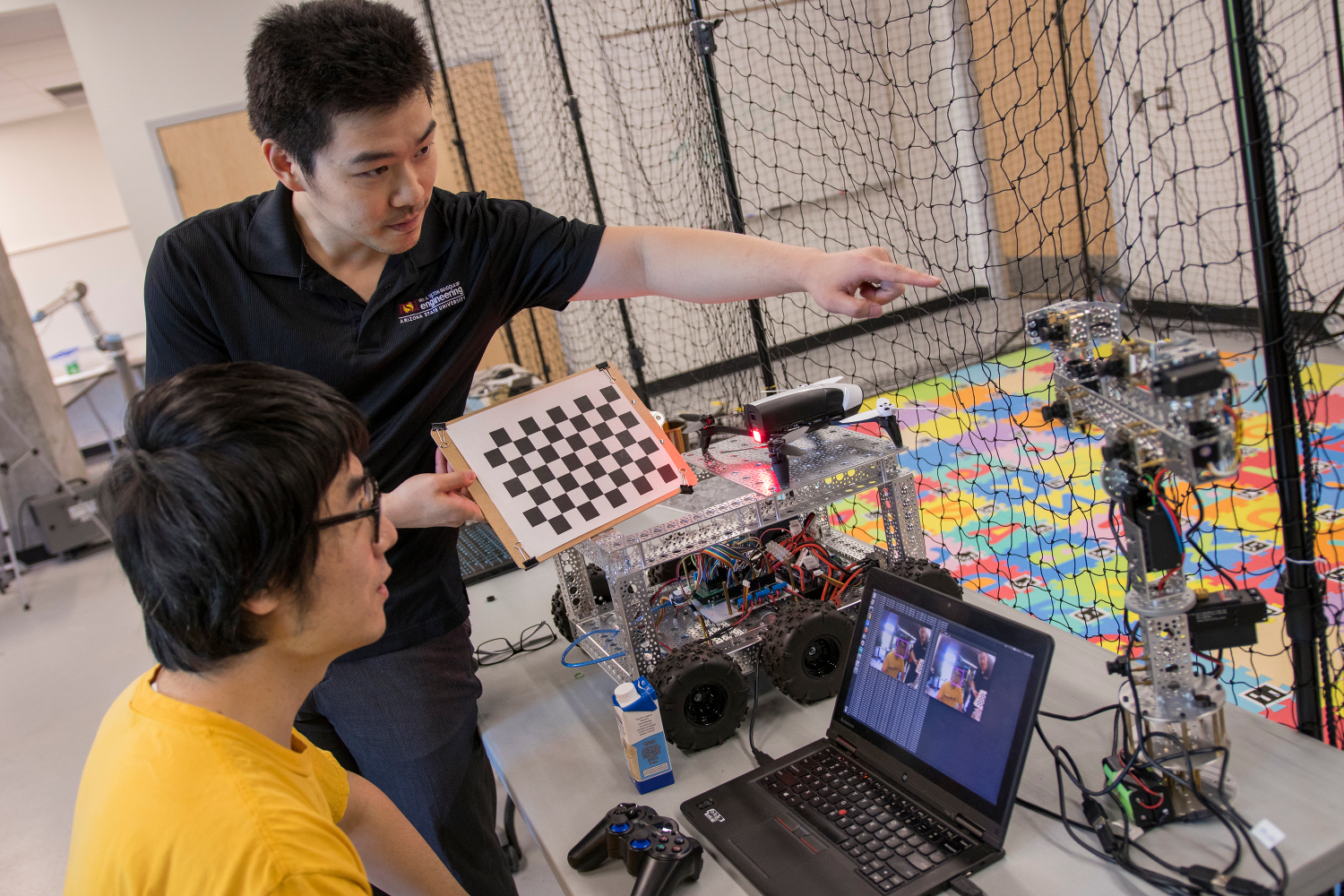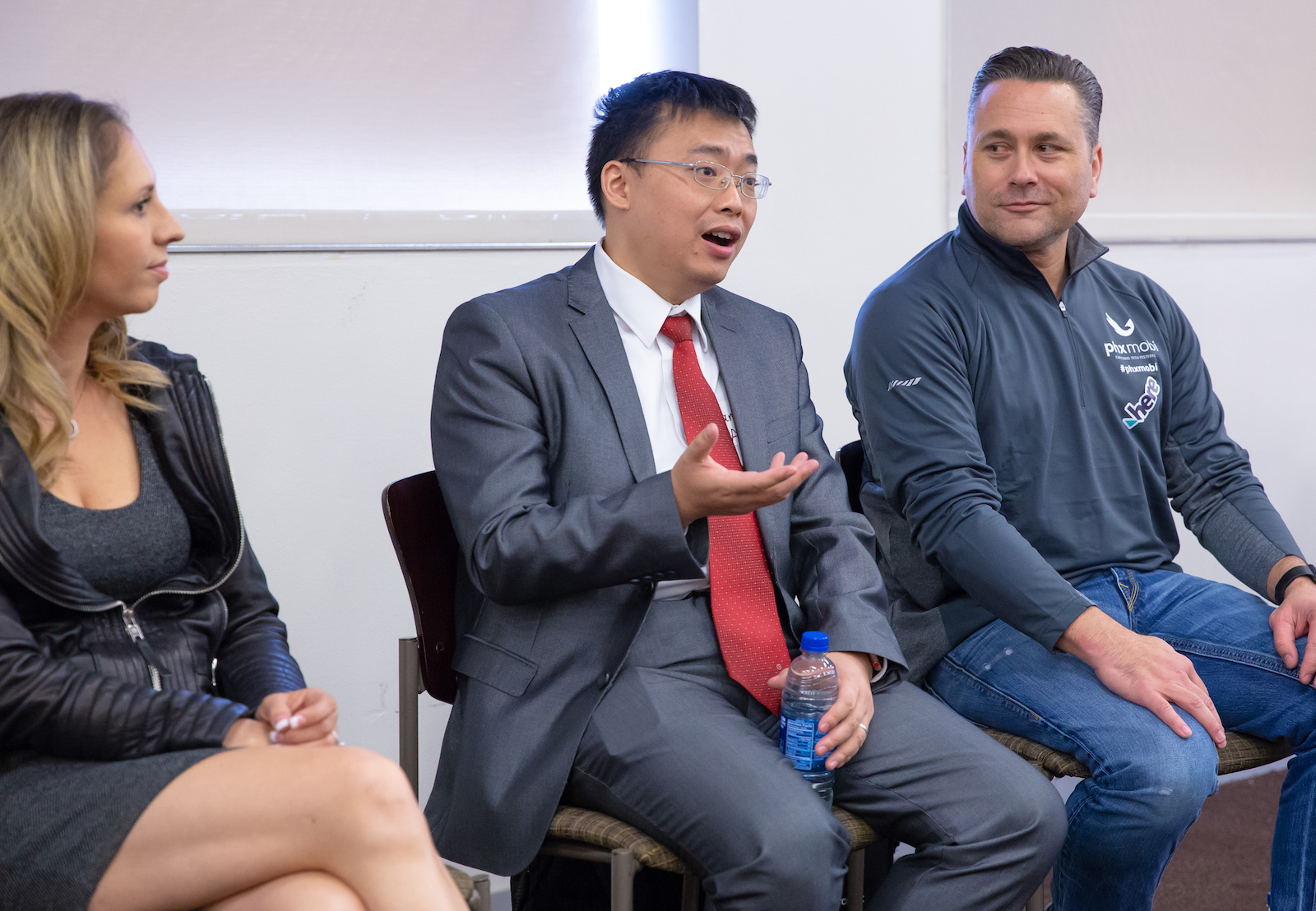Engineering evolutionary steps in automated mobility

A synchronized mix of advanced computing, sensing, robotics, artificial intelligence and mechanical-electrical control technologies will be necessary to create effective automated mobility systems. Research teams in the Ira A. Fulton Schools of Engineering at Arizona State University are aiding efforts by Arizona’s Institute of Automated Mobility to make such systems a part of the state’s future transportation landscape. Photo courtesy of Shutterstock
Engineers and scientists envision a future transportation environment with automated vehicles functioning safely and efficiently. They also see the many technological advances and refinements needed to make that scenario a reality.
Innovations in computing, robotics and artificial intelligence technologies are essential to the endeavor. Strides in the capabilities of sensing and detection devices and mechanical-electrical control systems are also critical.
Achieving those enhancements would help meet a major challenge in the development and adoption of automated modes of transport: assuring the public it can be confident about letting autonomous vehicles do the driving.
Research led by Yan Chen and Yezhou Yang focuses on facets of both the engineering and computer science most applicable to crafting key elements of smart transportation and traffic management systems.
The efforts of the assistant professors in Arizona State University’s Ira A. Fulton Schools of Engineering have been boosted by their recruitment more than a year ago to collaborate with the Institute of Automated Mobility, or IAM.
The consortium officially established in 2018 by Arizona Gov. Doug Ducey brings together public policy leaders, private industries and university research faculty to put Arizona at the forefront in the development of automated vehicles and the infrastructure to support them.
The goal is to build a research “ecosystem” structured to yield state-of-the-art development, design, testing and evaluation of automated mobility, said Marisa Walker, who directs the project as part of her duties as a senior vice president for strategic planning and infrastructure with the Arizona Commerce Authority, which oversees the IAM.
Range of research resources to be mobilized

Fulton Schools Assistant Professor Yezhou Yang (standing) directs computer science doctoral student and graduate research assistant Duo Lu in Yang’s Active Perception Group lab at Arizona State University. Research conducted by the group includes projects focused on technologies for use in automated mobility systems. Photo by Marco-Alexis Chaira/ASU
Chen brings to the job his expertise in the design, modeling, estimation, control and optimization of dynamic systems, specifically for automated and electric ground vehicles. He came to The Polytechnic School, one of the six Fulton Schools, after three years as an industrial researcher with Ford Motor Company and Cummins, a multinational corporation that designs and manufactures engines and power generation products.
Yang is a computer scientist in the School of Computing, Informatics, and Decision Systems Engineering, another of the Fulton Schools, whose research experience encompasses computational tools and the underlying mechanisms of robotic manipulation, and also includes computer vision, autonomous intelligent robots and artificial intelligence.
Chen and Yang’s skills align with the IAM’s primary research thrusts, in particular the development of ways to ensure reliable interactions between automated and human-driven vehicles. A related focus involves placing image and video processing technologies at road intersections. Those sensing and monitoring installations will provide data on various potential traffic scenarios for which automated vehicles must be equipped to respond adroitly.
The researchers also want to produce calculations necessary to establish a comprehensive set of safety metrics as part of performance standards for automated vehicles. Another objective is to develop methods and technologies that enable vehicle operation and response systems to adapt to different so-called “driving cultures.”
Yang already is teamed with Fulton Schools assistant professors Wenlong Zhang and Yi Ren on a project supported by the National Science Foundation to formulate algorithms for automated vehicles that anticipate the moves of other vehicles. A key goal is to make automated vehicles capable of responding to the motions of other vehicles whose drivers’ actions in different locales and situations will be guided by routines, habits and social customs “according to their local cultures,” Yang said.
Such undertakings will require adept application of advanced control engineering, machine learning, cognitive science and related areas of expertise that Yang, Chen and members of their ASU research teams can provide to the IAM.
Yang and Chen’s work is “right on the cutting edge of the kind of far-reaching progress we need to make,” said IAM leader Walker.
Data-based traffic management strategies and safety metrics
A computer visualization shows a 3D bounding box-based vehicle detection and tracking system at a street intersection in Arizona. The technique is widely used to train self-driving cars to recognize traffic signals, lane demarcations, obstacles, pedestrians and various objects in environments automated vehicles will encounter. Image courtesy of the Active Perception Group lab at ASU
Walker points to contributions already made by Yang and Chen that enable traffic engineering studies to advance from 2D to 3D perceptual scenarios.
Those scenarios “give us much more clarity on the things we need awareness of” in preparing to introduce automated mobility into communities, Walker said.
“We’ve looked at a lot of different tools out there, and we haven’t seen anything like it. So, it really is a testament to what they and their teams are doing that can help the IAM,” she said.
By combining efforts underway in Yang’s Active Perception Group and Chen’s Dynamic Systems and Control Laboratory at ASU, the two researchers are intent on bolstering the consortium’s mission by providing a well-grounded understanding of the many factors that can shape the contours of transportation landscapes. Part of that effort will be what scientists call “uncertainty modeling,” which strives to provide data-based strategies for navigating unpredictable environments.
Walker says those pursuits can help to guide the IAM’s approach to planning future modifications of transportation infrastructure to remedy the state’s toughest traffic management and safety challenges.
Outcomes of Yang and Chen’s research, Walker adds — especially baseline data for automated mobility safety metrics — should also be of particular interest to the IAM’s industry members, which include Intel’s Mobileye automated driving company, State Farm insurance company and Exponent, an engineering, scientific, environmental and health consulting services company.

The image shows a top-down computer visualization of vehicles — each colored box representing one vehicle — being tracked near a road intersection. The estimated speed of each vehicle is indicated by the numbers shown next to each colored box. The illustration is produced by technology developed in the Active Perception Group lab for research on automated mobility. The visualization combines a photo from the Active Perception Group lab and a Google Earth satellite image. Image courtesy of Yezhou Yang
Setting stage for smart transportation infrastructure
Yang and Chen are using an emerging mobility data gathering method called naturalistic driving that researchers say produces more precise analysis of the interactive relationships between drivers, vehicles, other road users and traffic conditions in both typical and atypical situations.
The work blends effectively with “the highly innovative and collaborative industry research and development environment within IAM,” said Dario Solis, who helps to manage ASU’s relationship with the IAM as an associate research administrator with the Business Engagement Catalyst, the Fulton Schools corporate relations team. The team matches the expertise of university researchers with specific industry research needs.
The combined impacts of the university and industry efforts eventually “will help generate real-life products and services for the autonomous vehicles of the future,” Solis said.
Beyond that progress, he envisions growing, long-term IAM research pursuits that will enlist more faculty and students from each of Arizona’s three state universities to partner with industry on projects to improve technologies important to advancing smart transportation systems and devices.
Solis says those endeavors will necessitate upgrades, for instance, in wireless networks, communication networks, human-machine interactions and other high-tech breakthroughs that will enable integration of automated mobility into the infrastructures of future smart cities.
All of which, Solis adds, will have a positive economic impact by creating the need for skilled labor forces to provide the services and technical know-how to fulfill the promise of a world of automated mobility.

Fulton Schools Assistant Professor Yan Chen (center) speaks during a panel discussion about automated vehicles at the 2018 Phoenix Mobile and Emerging Tech Festival. Chen is applying his expertise in dynamic systems — specifically those for automated and electric ground vehicles — to pursuing advances in automated driving and smart transportation. Photo courtesy of Yan Chen/ASU
More Science and technology

ASU researcher part of team discovering ways to fight drug-resistant bacteria
A new study published in the Science Advances journal featuring Arizona State University researchers has found…

ASU student researchers get early, hands-on experience in engineering research
Using computer science to aid endangered species reintroduction, enhance software engineering education and improve semiconductor…

ASU professor honored with prestigious award for being a cybersecurity trailblazer
At first, he thought it was a drill.On Sept. 11, 2001, Gail-Joon Ahn sat in a conference room in Fort Meade, Maryland.…